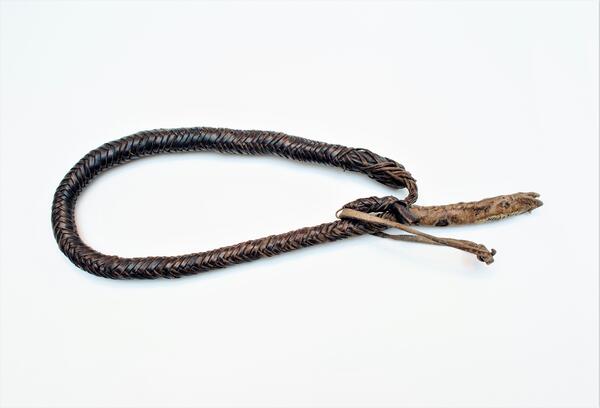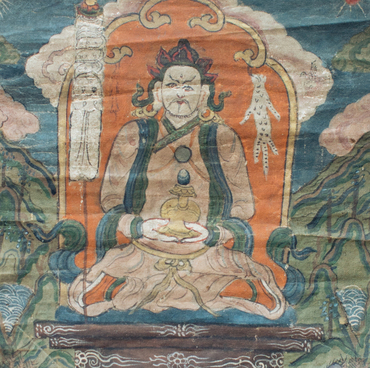The Tuvan people bred horses since the olden days, which were used for riding and transporting goods. Horses were also considered loyal friends and helpers and they were praised in folklore.
Tuvan horses were great for farming: they were considered low maintenance, requiring no special care, and could forage on their own all year round, even from under deep snow. No special premises were built for their keeping, just ordinary sheds, sometimes only fences with no roof whatsoever. Horses were used to travel across the relatively flat, valley part of Tuva. In places where horses could not pass, for example, taiga, foothills, or deep snow, Tuvans changed to reindeer.
A lariat was part of a horse harness. It could be woven from horsehair or hair of a sarlyk — a large semi-wild yak. A leather lariat was called sydym. It was an elastic rope about a centimeter thick, with a loop at the end. Leather lariats could be divided into one-layered and double-layered. The former was made from the skin from an ox’s or a red deer’s neck, while the latter was made from the skins of domestic animals. Double-layered lariats were considered more durable. The length was usually 7 to 9 Russian swung sazhens (kulash), which is about 12 meters. Each rider could adjust it depending on the length of their arms so that it was more convenient to fold it before throwing.
Before saddling a wild horse, it had to be caught first. Sydym was also used for this very purpose. Tuvans called this ritual shalbalaar.
Catching horses with a lariat had to be done every time after they were let to rest in the herd for a while. Mostly shepherds threw a lariat around their necks from the ground. Another way was to let the lariat lie on the ground so that it would grab the front legs of a running animal. There were about 12 ways of gambreling.
Sometimes the rope was thrown while riding another horse. In that case, one end of it was attached to a saddle. The lariat was put under the saddle from the left side, stretched under the horse’s belly and near the left stirrup, and then it was fastened to the front pommel. This method was called tapchor.
Tuvan horses were great for farming: they were considered low maintenance, requiring no special care, and could forage on their own all year round, even from under deep snow. No special premises were built for their keeping, just ordinary sheds, sometimes only fences with no roof whatsoever. Horses were used to travel across the relatively flat, valley part of Tuva. In places where horses could not pass, for example, taiga, foothills, or deep snow, Tuvans changed to reindeer.
A lariat was part of a horse harness. It could be woven from horsehair or hair of a sarlyk — a large semi-wild yak. A leather lariat was called sydym. It was an elastic rope about a centimeter thick, with a loop at the end. Leather lariats could be divided into one-layered and double-layered. The former was made from the skin from an ox’s or a red deer’s neck, while the latter was made from the skins of domestic animals. Double-layered lariats were considered more durable. The length was usually 7 to 9 Russian swung sazhens (kulash), which is about 12 meters. Each rider could adjust it depending on the length of their arms so that it was more convenient to fold it before throwing.
Before saddling a wild horse, it had to be caught first. Sydym was also used for this very purpose. Tuvans called this ritual shalbalaar.
Catching horses with a lariat had to be done every time after they were let to rest in the herd for a while. Mostly shepherds threw a lariat around their necks from the ground. Another way was to let the lariat lie on the ground so that it would grab the front legs of a running animal. There were about 12 ways of gambreling.
Sometimes the rope was thrown while riding another horse. In that case, one end of it was attached to a saddle. The lariat was put under the saddle from the left side, stretched under the horse’s belly and near the left stirrup, and then it was fastened to the front pommel. This method was called tapchor.



